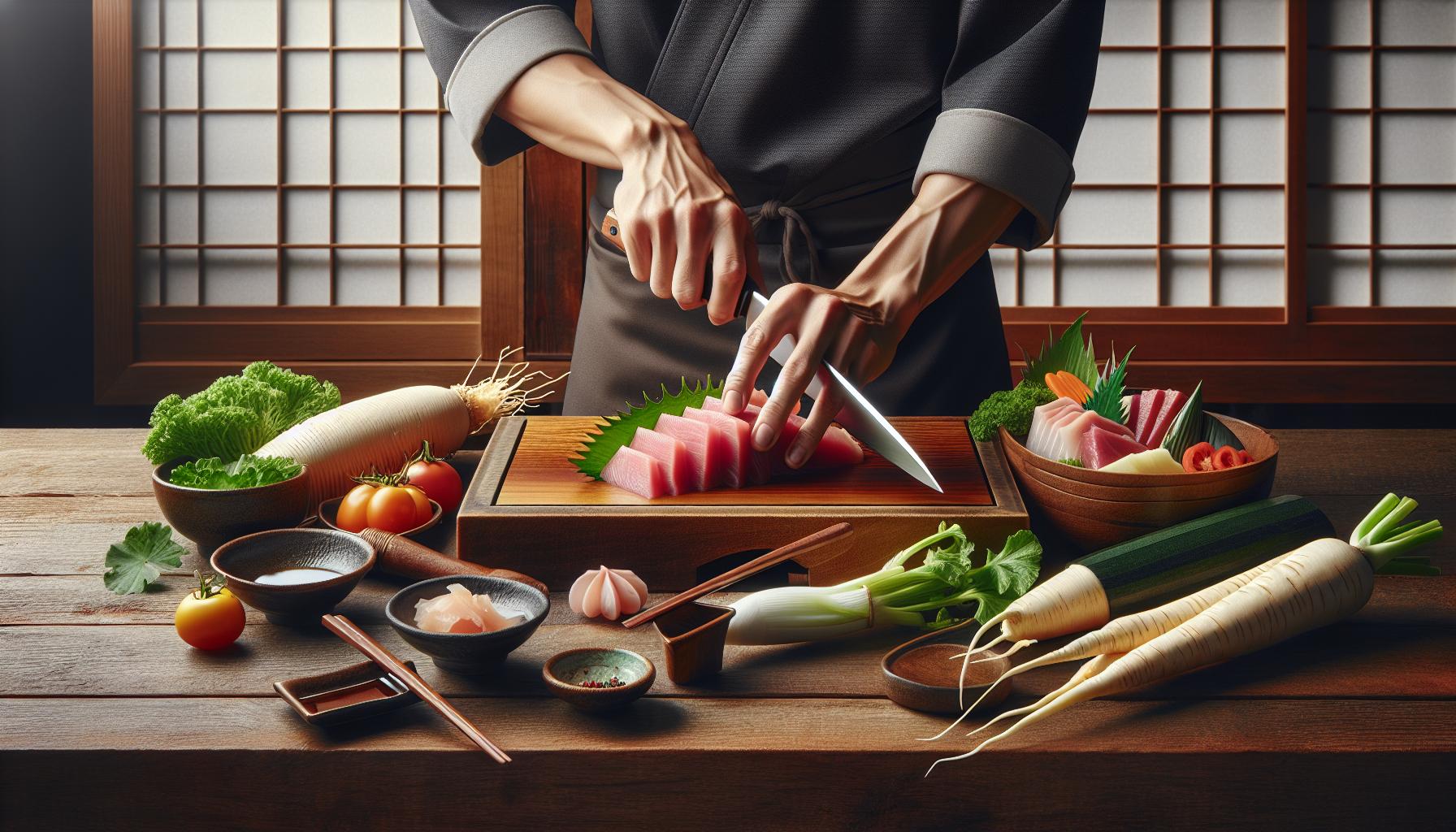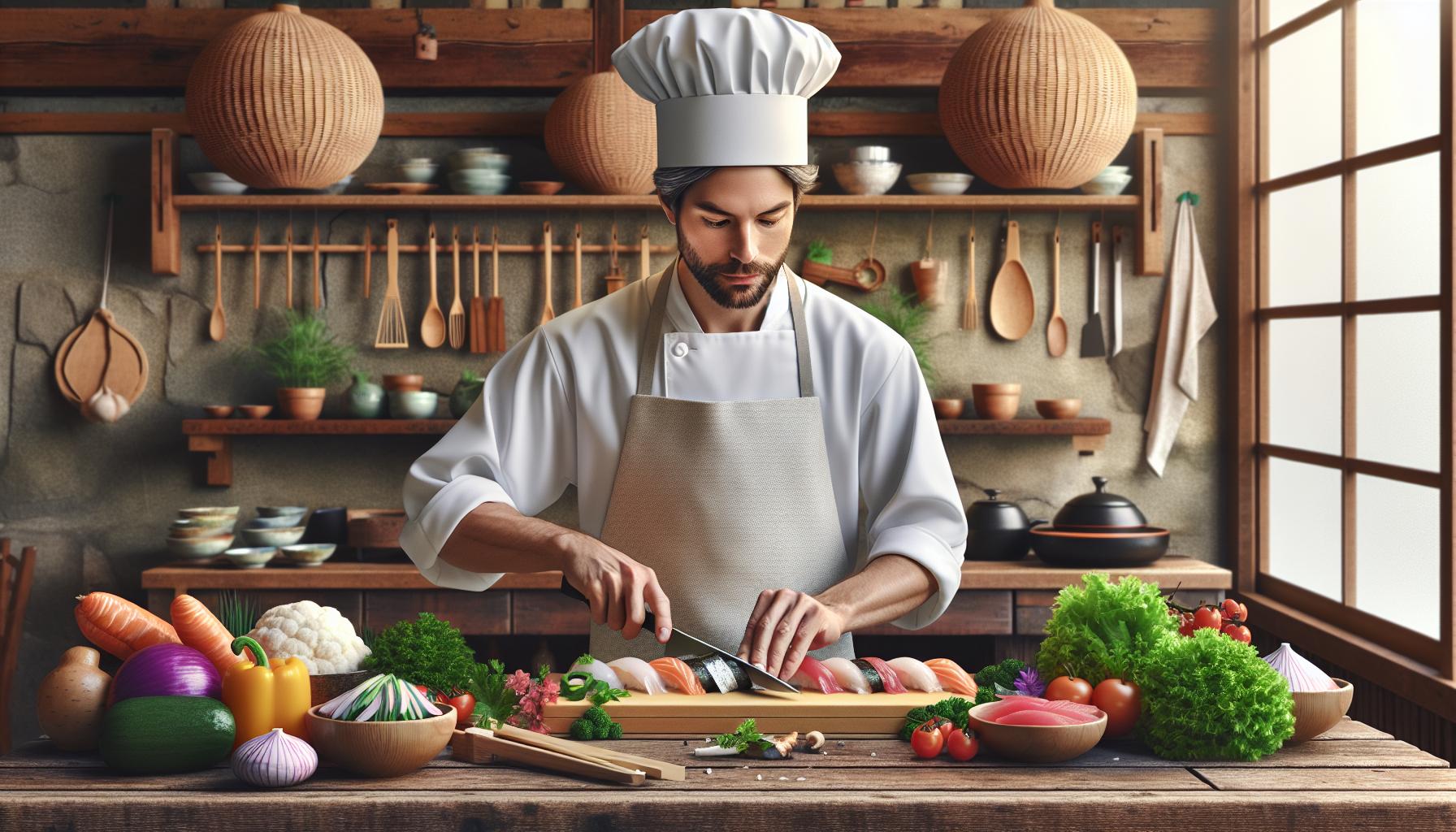Japanese cuisine has captivated food lovers worldwide with its meticulous preparation methods and artistic presentation. From the precise knife skills of katsuramuki to the delicate art of preparing sushi rice these time-honored techniques transform simple ingredients into culinary masterpieces.
Behind every perfectly rolled maki and precisely grilled yakitori lies a world of cooking methods that Japanese chefs spend years mastering. While some might think it’s all about raw fish and rice modern Japanese cooking encompasses a diverse range of techniques including nimono (simmering) mushimono (steaming) and the famous teppanyaki (flat top grilling). These methods don’t just cook food – they elevate everyday ingredients into dishes that celebrate texture flavor and visual appeal.
Essential Japanese Cooking Techniques and Methods
Japanese cuisine employs specific preparation methods that enhance natural flavors. These techniques include:
Nimono (煮物) – Simmering
- Simmers ingredients in dashi broth with sake, soy sauce, mirin
- Creates tender textures while infusing umami flavors
- Maintains nutrients through gentle cooking temperatures
- Works best for root vegetables, fish, tofu
Yakimono (焼き物) – Grilling
- Utilizes direct heat on konro grills or hibachi
- Applies fish skin-side up first for optimal crispiness
- Creates signature char marks on proteins
- Preserves moisture through precise timing
Mushimono (蒸し物) – Steaming
- Uses bamboo steamers for delicate ingredients
- Retains natural colors textures flavors
- Creates light tender results without added fats
- Perfect for fish dumplings seasonal vegetables
- Controls oil temperature between 160-180°C
- Drains excess oil on specific paper configurations
- Creates light crispy tempura batters
- Produces golden katsu cutlets
- Preserves vegetables in salt brine vinegar solutions
- Develops umami through fermentation processes
- Creates crunchy texture profiles
- Balances meal flavors through acidity
| Technique | Temperature Range | Cooking Time |
|---|---|---|
| Nimono | 85-95°C | 15-45 min |
| Yakimono | 200-250°C | 5-15 min |
| Mushimono | 95-100°C | 8-20 min |
| Agemono | 160-180°C | 2-5 min |
| Tsukemono | Room temp | 2-72 hrs |
Knife Skills in Japanese Cuisine

Japanese knife skills emphasize precision cutting techniques that enhance both presentation and flavor release in ingredients. The mastery of proper knife handling forms the foundation of Japanese cooking expertise.
Types of Japanese Knives
Japanese kitchens utilize specialized knives for distinct cutting tasks:
- Yanagiba: A single-beveled knife for slicing raw fish featuring a 9-12 inch blade
- Deba: A heavy-duty knife with a thick spine for breaking down whole fish weighing 7-8 ounces
- Usuba: A vegetable knife with a straight edge for precise cuts measuring 6-7 inches
- Nakiri: A double-beveled vegetable cleaver ideal for straight cuts spanning 6-7 inches
- Santoku: An all-purpose knife for meat vegetables fish combining three cutting techniques in a 5-7 inch blade
- Katsuramuki: Creates paper-thin vegetable sheets by rotating the ingredient against the blade
- Rangiri: Produces diagonal cuts in round vegetables like carrots through a roll-cutting motion
- Sogigiri: Makes thin slices by drawing the knife at a 30-degree angle across ingredients
- Uzugiri: Creates thin round slices through a precise pushing motion
- Wagarashi: Generates fine strips by stacking ingredients cutting them lengthwise then crosswise
| Cutting Technique | Primary Use | Typical Thickness |
|---|---|---|
| Katsuramuki | Daikon cucumber | 0.1-0.3mm |
| Rangiri | Carrots celery | 0.5-1cm |
| Sogigiri | Fish meat | 0.3-0.5cm |
| Uzugiri | Green onions herbs | 0.2-0.4cm |
Traditional Cooking Methods
Japanese cuisine employs distinct cooking techniques that transform ingredients into flavorful dishes while preserving their natural qualities. Each method showcases specific temperature ranges time requirements to achieve optimal results.
Nimono (Simmering)
Nimono involves simmering ingredients in dashi-based cooking liquid at 185-195°F (85-90°C). The ingredients absorb the umami-rich broth during a 20-45 minute cooking process, creating tender textures in vegetables meats. Key components include kombu seaweed dashi konbu chicken or fish stock combined with soy sauce mirin sake. Popular nimono dishes include nikujaga (meat potato stew) kabocha no nimono (simmered pumpkin) rafute (Okinawan braised pork belly).
Yakimono (Grilling)
Yakimono encompasses grilling techniques using direct heat at temperatures between 400-450°F (204-232°C). The method creates distinctive char marks sears proteins locks in moisture produces smoky aromas. Robata-style grilling uses specialized charcoal called binchotan which burns at consistent temperatures reaches up to 1,000°F (538°C). Common yakimono preparations include yakitori (grilled chicken skewers) shioyaki (salt-grilled fish) yakiniku (grilled meat).
Mushimono (Steaming)
Mushimono utilizes bamboo steamers to cook ingredients at 212°F (100°C) for 8-15 minutes. The technique preserves nutrients maintains natural flavors creates silky textures without added fats. Specialized equipment includes bamboo steamers wa-gata steaming baskets ceramic vessels. Traditional mushimono dishes feature chawanmushi (savory egg custard) sakamushi (sake-steamed fish) vegetables prepared with minimal seasonings.
Rice Preparation Techniques
Rice preparation forms the foundation of Japanese cuisine, requiring specific techniques to achieve the perfect texture and consistency. The process involves precise measurements and careful attention to detail at each step.
Washing and Soaking
Japanese rice preparation begins with thorough washing to remove excess starch. The process involves rinsing the rice in cold water 4-5 times until the water runs clear. A gentle circular motion with the palm creates optimal friction without breaking the grains. Short-grain Japanese rice requires 30 minutes of soaking at room temperature before cooking to achieve proper hydration. Premium varieties like Koshihikari absorb 15-20% of their weight in water during this stage. This essential step ensures even cooking throughout each grain.
Perfect Steamed Rice
Japanese rice cooking relies on precise water-to-rice ratios: 1.1:1 for new harvest rice or 1.2:1 for aged rice. An electric rice cooker maintains a consistent temperature of 212°F (100°C) during the cooking phase. The initial high heat phase lasts 5-7 minutes followed by a 15-minute steaming period at medium heat. The final resting phase requires 10-15 minutes with the lid closed. This method creates rice with distinct grains that stick together when picked up with chopsticks yet separate easily in the mouth.
| Rice Type | Water Ratio | Soaking Time | Cooking Time |
|---|---|---|---|
| New Harvest | 1.1:1 | 30 minutes | 20-22 minutes |
| Aged Rice | 1.2:1 | 30 minutes | 22-25 minutes |
Dashi and Stock Making
Dashi forms the foundation of Japanese cuisine, providing essential umami flavors to countless dishes. This versatile stock enhances soups, sauces, marinades with its rich savory depth.
Primary Dashi Ingredients
The core components of traditional dashi include kombu (dried kelp), katsuobushi (dried bonito flakes), niboshi (dried sardines) and shiitake mushrooms. Kombu contains high concentrations of glutamic acid, creating the signature umami taste. Katsuobushi adds smoky notes through its curing process of smoking, fermentation and sun-drying. Fresh shiitake mushrooms offer earthy undertones with natural glutamates. High-quality ingredients produce superior dashi – premium kombu displays a white powder coating while katsuobushi maintains its original pink-brown color.
Stock Preparation Steps
Making dashi starts with cold-soaking kombu in filtered water for 30 minutes at room temperature. The kombu steeps until small bubbles form at 140°F (60°C), then gets removed to prevent bitterness. Katsuobushi steeps for 30 seconds at 185°F (85°C) before straining. Double-brewing creates stronger dashi by using fresh ingredients with the first batch liquid. Alternative methods include cold-brewing kombu for 12 hours or quick-steeping katsuobushi for 10 minutes in hot water. Straining through fine-mesh sieves produces clear, debris-free stock.
| Ingredient | Steeping Temperature | Steeping Time |
|---|---|---|
| Kombu | 140°F (60°C) | 30 minutes |
| Katsuobushi | 185°F (85°C) | 30 seconds |
| Cold-brew Kombu | Room temp | 12 hours |
| Quick Katsuobushi | 185°F (85°C) | 10 minutes |
Presentation and Plating
Japanese culinary presentation transforms dishes into visual masterpieces through meticulous attention to detail and artistic arrangement. The philosophy of moritsuke (food arrangement) emphasizes the harmony between food and vessel while incorporating seasonal elements to create an engaging dining experience.
Seasonal Elements
Japanese plating reflects nature’s changing rhythms through carefully selected garnishes, plates and decorative elements. Maple leaves adorn autumn dishes while cherry blossoms grace spring presentations. Seasonal ingredients like bamboo shoots in spring or matsutake mushrooms in fall take center stage on plates. Colors align with each season: cool green tones for summer dishes contrast with warm earth tones for winter meals. Traditional vessels complement these seasonal themes, from glass bowls showcasing summer’s lightness to earthenware highlighting winter’s heartiness.
Balance and Aesthetics
Japanese plating follows the principle of asymmetrical balance using odd numbers of items. Chefs arrange food at 60% capacity of plates, creating negative space called “ma” that enhances visual impact. Color combinations incorporate five traditional colors: red, black, white, yellow green. Foods display varied heights textures shapes to create depth dimension. Garnishes like shiso leaves carved daikon serve both decorative functional purposes. Plate selections complement food characteristics: rectangular plates for sushi round bowls for soups lacquerware for formal presentations.
Conclusion
Japanese cooking techniques represent a harmonious blend of precision artistry and time-honored traditions. From the meticulous knife skills to the careful preparation of dashi these methods have stood the test of time while continuing to influence modern culinary practices worldwide.
Mastering these techniques requires dedication patience and respect for ingredients. Whether it’s perfecting the art of rice cooking achieving the ideal simmering temperature for nimono or creating visually stunning presentations each element plays a crucial role in crafting authentic Japanese dishes.
The enduring appeal of Japanese cuisine lies not just in its flavors but in its ability to transform simple ingredients into extraordinary culinary experiences through these refined techniques.

